Whether you have a home with a backyard or an apartment with a balcony, the fun of birding can be enjoyed by all. There are over 800 bird species in North America, and as many as 500 can be found in Texas alone. This rich diversity of birdlife is a testament to the diversity of habitat in Texas.
The state’s biodiversity is easily grasped when the high number of ecoregions in Texas—ten to be exact—are taken into account.
An ecoregion denotes a geographic area of similarity in its mosaic of flora, fauna, and ecosystems.
Texas’s geographic location is a crossroads where eastern habitats meet western ones and southern subtropical habitats meet northern temperate ones. Adding to the state’s super-birding aspects is the fact that it’s situated smack dab in the central flyway. During the spring and fall migrations, birders are apt to see species that aren’t generally seen otherwise. The Woodlands is situated in the Piney Woods ecoregion.
How to attract birds to your landscape
By providing these essentials, backyards can be easily become bird-friendly spaces.
- Food: feeders and native food-producing plants
- Clean water
- Shelter: shrubs, trees and birdhouses
What’s growing in the backyard is key and selecting native plants is a great place to start as they can provide both food and shelter. See the chart below for a short-list of just some of the native plants found in the Piney Woods ecoregion. And remember—the best habitats address all four layers of your landscape—canopy, understory, high ground, and ground.
Plants for Attracting Birds
Canopy Trees
- Provide Shelter
- Water Oak
- Sothern Red Oak
- Shumard Oak
- Drummond's Red Maple
- Sugarberry (Hackberry)
Understory Trees
- Provider shelter and fruit
- Mexican Plum
- Parsley Hawthorn
- Roughleaf Dogwood
- Possumhaw
- Yaupon Holly
Shrubs
- Provide shelter and fruit
- Arrowood Viburnum
- Rusty Blackhaw Viburnum
- Turk's Cap
- American Beautyberry
- Wax Myrtle
Herbaceous Plants
- Provide sees and nectar, and food for insects which in turn, are food for birds
- Blazing Star
- Milkwee
- Coneflower
- Blue Safe
- Lanceleaf Coreopsis
- Indian Blanket
Birds of the Piney Woods
Here’s a look at some common and less-common birds that visit The Woodlands backyards—either year-round or seasonally during migration. See how many visit your backyard feeder this season.
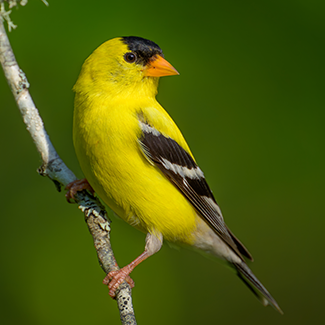
American Goldfinch
Perky little bird with conspicuous flying pattern. Spring and fall migrations bring flocks up to 20 birds. Males, usually bright yellow as in the picture shown, change to a greener yellow similar to females in the winter.
Food: seeds (partial to thistle) and insects
 American Robin
American Robin
The robin can be seen year-round in The Woodlands, but large flocks migrate through our area during spring and fall. Males with dark, almost black heads can be differentiated by females with gray head.
Food: insects, fruit, berries, worms
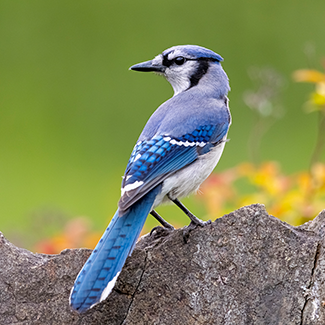 Blue Jay
Blue Jay
Jay’s are highly intelligent, solving problems, gathering food, and communicating more than other birds. Known as the alarm of the forest, they scream at intruders warning other birds of danger. They are one of the few birds to cache food.
Food: insects, fruit, carrion, seeds and nuts

Carolina Chickadee
These friendly little guys aren’t shy and are usually the first to use a new feeder. They use their feet to hold seed and their bill to hammer it open. High, fast song.
Food: insects, seeds, fruit
 Carolina Wren
Carolina Wren
These little birds pack a punch with abundant, beautiful song, often heard as a duet between males and female. Males sing up to 40 different songs. Mates are long-term, remaining together throughout the year in permanent territories.
Food: insects, fruit, few seeds
 Cedar Waxwing
Cedar Waxwing
Their name is derived from its red wax-like wing tips and preference for the blueberry-like cones of the cedar. Spends most of its time at the tops of tall trees. While seen year-round, these birds do not nest in Texas. Large flocks in fall and winter visit native trees and shrubs when berries are abundant and ripe.
Food: cedar cones, fruit, insects
 Downy Woodpecker
Downy Woodpecker
The stiff tail feathers of this small woodpecker are stiff and used as a tripod to help brace it as it clings to a tree. Like all woodpeckers, it has a long barbed tongue to extract insects from tiny places. Male and female will drum on branches or hollow logs to announce territories.
Food: insects, seeds, and will visit a suet feeder
 Eastern Bluebird
Eastern Bluebird
This beautiful bird was once nearly eliminated from Texas due to loss of habitat. They nest in cavities of dead trees often removed from our landscape. Fortunately, they have made a remarkable comeback with the help from bluebird enthusiasts who have set up thousands of bluebird nest boxes.
Food: insects, fruit
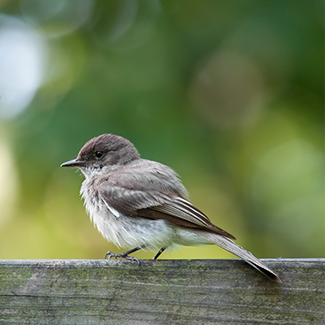 Eastern Phoebe
Eastern Phoebe
This little bird will sit on the end of a dead branch and wait for a passing insect. It then flies out to catch it and returns to its perch—a behavior called “hawking.” Has a habit of pumping its tail up and down when perched. Pretty, repetitive song.
Food: insects
 House Finch
House Finch
This is a very social bird and visits feeders in flocks. Likes to nest in hanging baskets.
Food: seeds, fruit, leaf buds
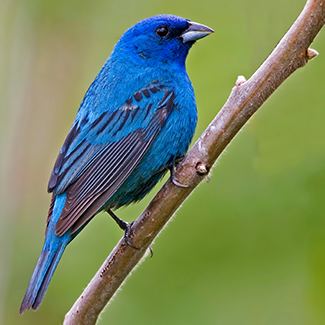 Indigo Bunting
Indigo Bunting
This is a secretive bird, and usually only the males (pictured) are seen. They are mostly seen along woodland edges, feeding on insects though males have been known to visit feeders in spring before insects are plentiful. They migrate at night in flocks of five to ten.
Food: insects, seeds, fruit
 Mourning Dove
Mourning Dove
Its name comes from its mournful cooing. Feeds on the ground. One of the few birds to drink without lifting its head.
Food: seeds
 Northern Cardinal
Northern Cardinal
Females have tan coloring and males are all red. These are a familiar backyard bird that can be seen year-round. Look for the male feeding the female during courtship. The males will also feed the young of the first brood while the female builds a second nest. Very territorial in spring, with males fighting their own reflection in a window.
Food: seeds, insects, fruit
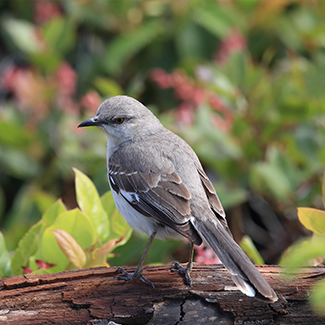 Northern Mockingbird
Northern Mockingbird
This bird is very animated, performing an elaborate mating dance. They are thought to flash their white wing patches to scare up insects. Great imitator of other birds, hence their name. This is the Texas State Bird.
Food: insects, fruit
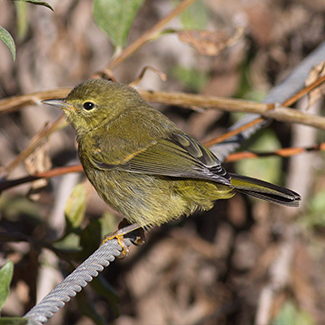 Orange-crowned Warbler
Orange-crowned Warbler
Seen more during migration when large groups move together. It builds a bulky, well-hidden nest on the ground with the rim at ground level. This is a tough bird to spot, as it tends to hide and rarely seen though it breeds from Texas to Alaska.
Food: insects, fruit, nectar
 Red-bellied Woodpecker
Red-bellied Woodpecker
Mostly found in shady woodlands, this bird excavates holes in rotten wood looking for spiders, centipedes, and beetles. Watch it hammer an acorn into tree crevices for winter food. It returns to the same tree to create a new nest below that of last year’s.
Food: insects, nuts, fruit, suet feeders
 Ruby-throated Hummingbird
Ruby-throated Hummingbird
This tiny guy is the smallest bird in the state—and the most agile. Able to hover, fly vertically, and the only bird to fly backwards. Hummingbirds do not sing, but chatter to communicate. Its wings flap 50–60 times a second; its heart beats 1,260 times each minute, and its lungs take 250 breaths a minute. Hummers are little machines on steroids.
Food: nectar, insects
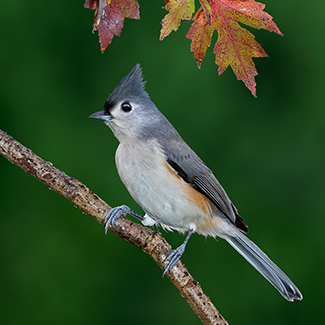 Tufted Titmouse
Tufted Titmouse
Common visitor to feeders—especially those offering black oil sunflower seeds. Known for its quickly delivered and repetitious song. These are brave little birds, notorious for pulling hair from sleeping dogs, cats, and squirrels to line their nests.
Food: seeds, insects
Beyond the backyard
Now that you have can identify the birds visiting your backyard, share your observations with the world! For aspiring and dedicated citizen scientists of all ages, check out Project FeederWatch, developed by the Cornell Lab of Ornithology at Cornell University. FeederWatch data helps scientists track broad-scale movements of winter bird populations and long-term trends in bird distribution and abundance.
Another great resource for birders is also brought to you by the Cornell Lab of Ornithology, eBird, where bird enthusiasts can connect to and contribute to the world of birding.
For more information, contact the Environmental Services Department at enviro@thewoodlandstownship-tx.gov or 281-210-3800.